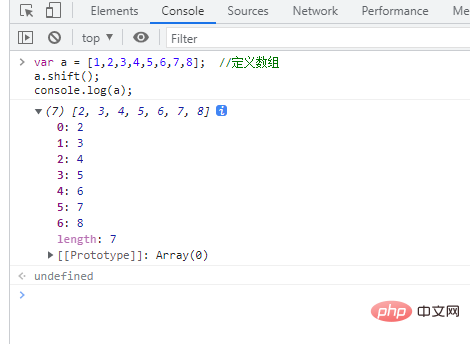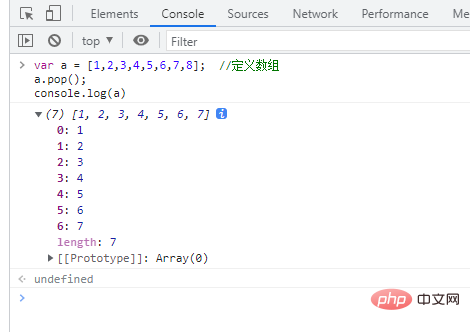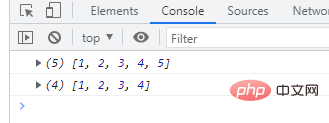How to delete an array element in es6
Method: 1. Use shift() to delete the first element, the syntax is "array.shift()"; 2. Use pop() to delete the last element, the syntax is "array.pop()"; 3 , use length to delete the last element, the syntax is "array.length=original array length - 1"; 4. Use delete to delete an element with a specified subscript, the syntax is "delete array name [subscript]"; 5. Use splice() to delete An element at any position, the syntax is "array.splice(position,1)".

The operating environment of this tutorial: Windows 7 system, ECMAScript version 6, Dell G3 computer.
Method 1: Use the shift() function to delete the first array element
array.shift() function can convert the array The first element is removed from it and the value of the first element is returned; then all remaining elements are shifted forward by 1 position to fill the gap at the head of the array.
var a = [1,2,3,4,5,6,7,8]; //定义数组 a.shift(); console.log(a);
The output result is:

Note: The shift() method will change the original array and modify the length of the array!
Method 2: Use pop() to delete the last array element
array.pop() method can delete the last element in the array , and returns the deleted element.
var a = [1,2,3,4,5,6,7,8]; //定义数组 a.pop(); console.log(a)
The output result is:

Note: The pop() method will also change the original array and modify the length of the array!
Method 3: Use the length attribute to delete the last array element
The length attribute of the array is generally used to set or return the elements in the array Number, that is, setting or returning the array length.
We can use the feature of setting the length of the array and set the length attribute to be smaller than the original length to delete one or more elements from the end of the array; if the value is set to 0, the entire array will be deleted. That is, clear the array!
Syntax:Array object.length=original array length-1;
Example:
var a = [1,2,3,4,5,6,7,8]; //定义数组 console.log(a) a.length=7; console.log(a)

Method 4: Use the delete operator to delete an element at the specified subscript
We all know that each element in the array has a serial number, and this serial number starts from Starting from 0, it is called the index. According to this array subscript, we can use the form array name[subscript] to access the element of the specified subscript.
After accessing the specified element, you can use the delete operator to delete the element, but the length of the array will not change; the deleted element will change It is a gap element.
var arr=new Array("香蕉","苹果","梨子","橙子","橘子","榴莲");
console.log(arr);
delete arr[1]; //删除下标为1的元素(第二个元素)
console.log(arr);
The gap element can be read and written. The length attribute does not exclude gaps. The return value of the null element position is undefined
console.log(arr[1]);

Explanation: An empty element and an element whose value is undefined are two different concepts. Even the return value of an empty element is undefined. When JavaScript initializes an array, it can allocate memory only if it actually stores valuable elements.
Method 5: Use splice() to delete an element at any position
Use splice() to delete an element from the specified subscript position Start deleting one or more elements.
Syntax for deleting elements:
array.splice(index,howmany)
The first parameter
indexcan specify the starting subscript position (that is, the position where the element is deleted) ;The second parameter
howmanyspecifies the number of elements that should be deleted (that is, one or more elements that need to be deleted).
You only need to set the second parameter howmany to 1, that is, delete an element at any index position.
Let’s take a closer look at the following example:
var arr= [1,2,3,4,5]; console.log(arr); arr.splice(1,1); console.log(arr);

Using the splice() method, we can also delete elements at the beginning and end of the array. :
If you want to delete elements at the beginning of the array, just set the value of the first parameter index of this method to 0
var arr= [1,2,3,4,5]; console.log(arr); arr.splice(0,1); console.log(arr);

If you want to delete an element at the end of the array, set the value of the first parameter index of this method to a negative number, then the absolute value will be calculated from the right side of the array to the Positioning on the left; and the value of the second parameter howmany must be equal to the value of index.
var arr= [1,2,3,4,5]; console.log(arr); //从倒数第1个元素开始,截取1个元素 arr.splice(-1,1); console.log(arr);

【相关推荐:javascript视频教程、web前端】
The above is the detailed content of How to delete an array element in es6. For more information, please follow other related articles on the PHP Chinese website!

Hot AI Tools

Undresser.AI Undress
AI-powered app for creating realistic nude photos

AI Clothes Remover
Online AI tool for removing clothes from photos.

Undress AI Tool
Undress images for free

Clothoff.io
AI clothes remover

Video Face Swap
Swap faces in any video effortlessly with our completely free AI face swap tool!

Hot Article

Hot Tools

Notepad++7.3.1
Easy-to-use and free code editor

SublimeText3 Chinese version
Chinese version, very easy to use

Zend Studio 13.0.1
Powerful PHP integrated development environment

Dreamweaver CS6
Visual web development tools

SublimeText3 Mac version
God-level code editing software (SublimeText3)

Hot Topics
 1665
1665
 14
14
 1424
1424
 52
52
 1322
1322
 25
25
 1269
1269
 29
29
 1249
1249
 24
24
 How to implement an online speech recognition system using WebSocket and JavaScript
Dec 17, 2023 pm 02:54 PM
How to implement an online speech recognition system using WebSocket and JavaScript
Dec 17, 2023 pm 02:54 PM
How to use WebSocket and JavaScript to implement an online speech recognition system Introduction: With the continuous development of technology, speech recognition technology has become an important part of the field of artificial intelligence. The online speech recognition system based on WebSocket and JavaScript has the characteristics of low latency, real-time and cross-platform, and has become a widely used solution. This article will introduce how to use WebSocket and JavaScript to implement an online speech recognition system.
 WebSocket and JavaScript: key technologies for implementing real-time monitoring systems
Dec 17, 2023 pm 05:30 PM
WebSocket and JavaScript: key technologies for implementing real-time monitoring systems
Dec 17, 2023 pm 05:30 PM
WebSocket and JavaScript: Key technologies for realizing real-time monitoring systems Introduction: With the rapid development of Internet technology, real-time monitoring systems have been widely used in various fields. One of the key technologies to achieve real-time monitoring is the combination of WebSocket and JavaScript. This article will introduce the application of WebSocket and JavaScript in real-time monitoring systems, give code examples, and explain their implementation principles in detail. 1. WebSocket technology
 How to use JavaScript and WebSocket to implement a real-time online ordering system
Dec 17, 2023 pm 12:09 PM
How to use JavaScript and WebSocket to implement a real-time online ordering system
Dec 17, 2023 pm 12:09 PM
Introduction to how to use JavaScript and WebSocket to implement a real-time online ordering system: With the popularity of the Internet and the advancement of technology, more and more restaurants have begun to provide online ordering services. In order to implement a real-time online ordering system, we can use JavaScript and WebSocket technology. WebSocket is a full-duplex communication protocol based on the TCP protocol, which can realize real-time two-way communication between the client and the server. In the real-time online ordering system, when the user selects dishes and places an order
 How to implement an online reservation system using WebSocket and JavaScript
Dec 17, 2023 am 09:39 AM
How to implement an online reservation system using WebSocket and JavaScript
Dec 17, 2023 am 09:39 AM
How to use WebSocket and JavaScript to implement an online reservation system. In today's digital era, more and more businesses and services need to provide online reservation functions. It is crucial to implement an efficient and real-time online reservation system. This article will introduce how to use WebSocket and JavaScript to implement an online reservation system, and provide specific code examples. 1. What is WebSocket? WebSocket is a full-duplex method on a single TCP connection.
 JavaScript and WebSocket: Building an efficient real-time weather forecasting system
Dec 17, 2023 pm 05:13 PM
JavaScript and WebSocket: Building an efficient real-time weather forecasting system
Dec 17, 2023 pm 05:13 PM
JavaScript and WebSocket: Building an efficient real-time weather forecast system Introduction: Today, the accuracy of weather forecasts is of great significance to daily life and decision-making. As technology develops, we can provide more accurate and reliable weather forecasts by obtaining weather data in real time. In this article, we will learn how to use JavaScript and WebSocket technology to build an efficient real-time weather forecast system. This article will demonstrate the implementation process through specific code examples. We
 Simple JavaScript Tutorial: How to Get HTTP Status Code
Jan 05, 2024 pm 06:08 PM
Simple JavaScript Tutorial: How to Get HTTP Status Code
Jan 05, 2024 pm 06:08 PM
JavaScript tutorial: How to get HTTP status code, specific code examples are required. Preface: In web development, data interaction with the server is often involved. When communicating with the server, we often need to obtain the returned HTTP status code to determine whether the operation is successful, and perform corresponding processing based on different status codes. This article will teach you how to use JavaScript to obtain HTTP status codes and provide some practical code examples. Using XMLHttpRequest
 How to use insertBefore in javascript
Nov 24, 2023 am 11:56 AM
How to use insertBefore in javascript
Nov 24, 2023 am 11:56 AM
Usage: In JavaScript, the insertBefore() method is used to insert a new node in the DOM tree. This method requires two parameters: the new node to be inserted and the reference node (that is, the node where the new node will be inserted).
 JavaScript and WebSocket: Building an efficient real-time image processing system
Dec 17, 2023 am 08:41 AM
JavaScript and WebSocket: Building an efficient real-time image processing system
Dec 17, 2023 am 08:41 AM
JavaScript is a programming language widely used in web development, while WebSocket is a network protocol used for real-time communication. Combining the powerful functions of the two, we can create an efficient real-time image processing system. This article will introduce how to implement this system using JavaScript and WebSocket, and provide specific code examples. First, we need to clarify the requirements and goals of the real-time image processing system. Suppose we have a camera device that can collect real-time image data




